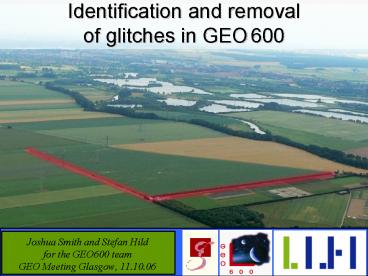Identification and removal of glitches in GEO 600 - PowerPoint PPT Presentation
1 / 26
Title:
Identification and removal of glitches in GEO 600
Description:
Not seen after work on the signal-recycling longitudinal error signal module around May. Broken switch from one error signal to another ... – PowerPoint PPT presentation
Number of Views:45
Avg rating:3.0/5.0
Title: Identification and removal of glitches in GEO 600
1
Identification and removal of glitches in GEO 600
- Joshua Smith and Stefan Hild for the
GEO600 team GEO Meeting
Glasgow, 11.10.06
2
Overview
After start of 24/7 S5 emphasis shifted toward
data quality Main glitch identification strategy
automatic characterization, mining this,
following up to find sources
- Main Tools
- GEO Summary pages
- HACR
- Coincident analysis
- Noise projections
- Now, KleineWelle
- Glitch Families
- The Owl
- Sine-Gaussians
- Dust
- Laser frequency
- MID slow FB
- Magnetic field/mains
3
The Owl
- Narrow line(s) with (sometimes) rapidly moving
frequency - Is partially controllable, but not in
well-understood way - Can cause poor data, glitches
4
Nevermore?
- Not seen after work on the signal-recycling
longitudinal error signal module around May - Broken switch from one error signal to another
- This cant be the ultimate cause of the owl owl
existed before this module
5
Owl and analysis
- No good veto found yet
- Could remove the areas of strongest owl presence
by eye (cyan squares)
6
Sine-Gaussians
- Few per day this summer. Source unknown
- First look indicates some vetoed by null-stream
(a combination of two GEO calibrated detector
outputs that yields close to no GW signal)
7
Power glitches vs. dust
Particle count
Dark port DC power glitch count
Dark port DC power glitch count
Dark port DC power glitch count
Input port DC power glitch count
0 Time
m 180
8
Air Conditioning particle filters
140 (90)?20 factor 5-7
45 (25)?5 factor 5-9
(Particles/cu.ft)/1000
3 (2)?0.2 factor 10-15
A a
9
Dust made loudest glitches
Det. output BLRMS _at_ 170Hz
Time h
Time h
Before filter
After filter
10
Dealing with dust
- Statistical vetoes look promising
11
Freq. Glitch Characteristics
0s
60s
- Show up strongly in all frequency stabilization
signals - Couple to H via frequency noise (MIC EP)
12
Removing MC2 glitches
2kHz
- Traced origin to mode-cleaner 2 loop. Suspected
saturation. - June 22nd Glitches drastically improved with 2x
reduction of RF modulation depth (compensated by
digital gain) - Surprise! Glitches return in July.
- Found to be a switching comparator in
modecleaner module, fixed glitches for good by
changing threshold for this device
June
Freq. Hz
30d
0d
13
Vetoes for frequency noise glitches
- Noise Projection vetoes (see Ajiths talk)
- Null-stream veto (Martins talk)
- Apply both, or in series?
14
Magnetic field glitches
H glitches
B glitches
Linear coupling, coherence
15
Magnetic field projection
- B-field nearly limiting noise around 100Hz?
- Coupling not yet understood
- Checks magnetometer measures B-field, IFO
back-coupling ruled out
16
Hourly mains glitches
- Hourly series start
- 24 secs after GPS hour
- 10 secs after UTC hour
17
Mag./mains coinc. with H
Magnetometer central building 50coinc./8hrs
Mains monitor central building 30coinc./8hrs
Time-freq glitch maps
Frequency Hz
Frequency Hz
0
0
8
8
Time h
Time h
50
50
Time-shifted coincidence
0
0
1
1
-1
-1
Time shift s
Time shift s
18
Dealing with mains glitches
- Could take out seconds 20 to 100 of every GPS
hour. - Statistical veto
- Filtering of Mains signal proposed for future
19
MID slow path glitches
- Looks like a switch!
20
Coincident with mains glitches
- Identify point of coupling already narrowed
- Filtering mains may help elsewhere
21
Glitch rate at Start/end of lock
Glitches about equally distributed over the lock
stretches. No excess at the beginning or end (for
May)
22
HACR History Plots
May
June
July
August
23
Summary
- Owl not seen after May 28
- Sine-Gaussians seen mainly in May-June
- Dust reduced drastically after May 22 by AC
filtering - Laser frequency removed after Sept 7
- MID slow FB traced to after digital feedback
last week - Magnetic field/mains mains filtering a possible
commissioning task - Current HACR glitch rate is about .035Hz
- Often 5 times that in May
24
New KleineWelle G1 Triggers
- Triggers online for S5 up till September
- http//lancelot.mit.edu/cadonati/S5/online/Kleine
Welle/ - Thanks to
- Laura Candonati, Lindy Blackburn for trigger
generation, summary pages - Chris messenger for segment list generation
25
END
26
Frequency stabilization































